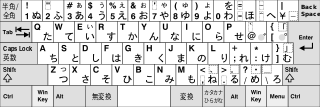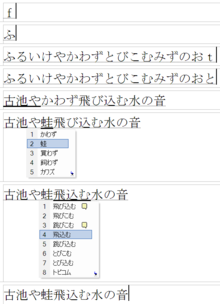Furigana is a Japanese reading aid consisting of smaller kana printed either above or next to kanji or other characters to indicate their pronunciation. It is one type of ruby text. Furigana is also known as yomigana (読み仮名) and rubi in Japanese. In modern Japanese, it is usually used to gloss rare kanji, to clarify rare, nonstandard or ambiguous kanji readings, or in children's or learners' materials. Before the post-World War II script reforms, it was more widespread.
Hiragana is a Japanese syllabary, part of the Japanese writing system, along with katakana as well as kanji.
Katakana is a Japanese syllabary, one component of the Japanese writing system along with hiragana, kanji and in some cases the Latin script.
Kana are syllabaries used to write Japanese phonological units, morae. Such syllabaries include (1) the original kana, or magana, which were Chinese characters (kanji) used phonetically to transcribe Japanese, the most prominent magana system being man'yōgana (万葉仮名); the two descendants of man'yōgana, (2) hiragana, and (3) katakana. There are also hentaigana, which are historical variants of the now-standard hiragana. In current usage, 'kana' can simply mean hiragana and katakana.

In relation to the Japanese language and computers many adaptation issues arise, some unique to Japanese and others common to languages which have a very large number of characters. The number of characters needed in order to write in English is quite small, and thus it is possible to use only one byte (28=256 possible values) to encode each English character. However, the number of characters in Japanese is many more than 256 and thus cannot be encoded using a single byte - Japanese is thus encoded using two or more bytes, in a so-called "double byte" or "multi-byte" encoding. Problems that arise relate to transliteration and romanization, character encoding, and input of Japanese text.
An input method is an operating system component or program that enables users to generate characters not natively available on their input devices by using sequences of characters that are available to them. Using an input method is usually necessary for languages that have more graphemes than there are keys on the keyboard.
The dakuten, colloquially ten-ten, is a diacritic most often used in the Japanese kana syllabaries to indicate that the consonant of a syllable should be pronounced voiced, for instance, on sounds that have undergone rendaku.
Wāpuro rōmaji (ワープロローマ字), or kana spelling, is a style of romanization of Japanese originally devised for entering Japanese into word processors while using a Western QWERTY keyboard.

The modern Japanese writing system uses a combination of logographic kanji, which are adopted Chinese characters, and syllabic kana. Kana itself consists of a pair of syllabaries: hiragana, used primarily for native or naturalised Japanese words and grammatical elements; and katakana, used primarily for foreign words and names, loanwords, onomatopoeia, scientific names, and sometimes for emphasis. Almost all written Japanese sentences contain a mixture of kanji and kana. Because of this mixture of scripts, in addition to a large inventory of kanji characters, the Japanese writing system is considered to be one of the most complicated currently in use.
In the Japanese language, the gojūon (五十音, Japanese pronunciation:[ɡo(d)ʑɯꜜːoɴ], lit. "fifty sounds") is a traditional system ordering kana characters by their component phonemes, roughly analogous to alphabetical order. The "fifty" (gojū) in its name refers to the 5×10 grid in which the characters are displayed. Each kana, which may be a hiragana or katakana character, corresponds to one sound in Japanese. As depicted at the right using hiragana characters, the sequence begins with あ (a), い (i), う (u), え (e), お (o), then continues with か (ka), き (ki), く (ku), け (ke), こ (ko), and so on and so forth for a total of ten rows of five columns.

The chōonpu, also known as chōonkigō (長音記号), onbiki (音引き), bōbiki (棒引き), or Katakana-Hiragana Prolonged Sound Mark by the Unicode Consortium, is a Japanese symbol that indicates a chōon, or a long vowel of two morae in length. Its form is a horizontal or vertical line in the center of the text with the width of one kanji or kana character. It is written horizontally in horizontal text and vertically in vertical text. The chōonpu is usually used to indicate a long vowel sound in katakana writing, rarely in hiragana writing, and never in romanized Japanese. The chōonpu is a distinct mark from the dash, and in most Japanese typefaces it can easily be distinguished. In horizontal writing it is similar in appearance to, but should not be confused with, the kanji character 一 ("one").
OpenVanilla (OV) is a free, open-source text-entry and processing architecture. It includes a collection of popular input methods and text processing filters, serving as a bridge between input methods and the operating system. It was originally designed to offer a better text-entry experience and alternative input methods not found in Apple's built-in set or suit better the needs for Windows "switchers." However, the developers have since worked on a Microsoft Windows port and a bridge between OV and SCIM on the X Window System. The macOS version is compatible with Mac OS X 10.3 (Panther) and Mac OS X 10.4 (Tiger). OV's input methods can also be used through SCIM on Linux or FreeBSD. An experimental Win32 Unicode version is also available.
Half-width kana are katakana characters displayed compressed at half their normal width, instead of the usual square (1:1) aspect ratio. For example, the usual (full-width) form of the katakana ka is カ while the half-width form is カ. Half-width hiragana is included in Unicode, and it is usable on Web or in e-books via CSS's font-feature-settings: "hwid" 1 with Adobe-Japan1-6 based OpenType fonts. Half-width kanji is usable on modern computers, and is used in some receipt printers, electric bulletin board and old computers.
ATOK is a Japanese input method editor (IME) produced by JustSystems, a Japanese software company.
Kotoeri (ことえり) is a discontinued Japanese-language input method that came standard with OS X and earlier versions of Classic Mac OS until OS X Yosemite. Kotoeri literally means "word selection".
Language input keys, which are usually found on Japanese and Korean keyboards, are keys designed to translate letters using an input method editor (IME). On non-Japanese or Korean keyboard layouts using an IME, these functions can usually be reproduced via hotkeys, though not always directly corresponding to the behavior of these keys.
The romanization of Japanese is the use of Latin script to write the Japanese language. This method of writing is sometimes referred to in Japanese as rōmaji.

A keyboard layout is any specific physical, visual, or functional arrangement of the keys, legends, or key-meaning associations (respectively) of a computer keyboard, mobile phone, or other computer-controlled typographic keyboard.

The thumb-shift keyboard is a keyboard design for inputting Japanese sentences on word processors and computers. It was invented by Fujitsu in the late 1970s and released in 1980 as a feature of the line of Japanese word processors the company sold, named OASYS, to make Japanese input easier, faster and more natural. It is popular among people who input large quantities of Japanese sentences, such as writers, playwrights, lawyers and so on, because of its ease of use and speed. The rights regarding the use of this design were transferred to Nihongo Nyuuryoku Consortium, a technology sharing cooperative of interested companies, in 1989. It is referred to as an example of keyboard layout in Japanese Industrial Standards.

MessagEase is an input method and virtual keyboard for touchscreen devices. It relies on a new entry system designed by Saied B. Nesbat, formatted as a 3x3 matrix keypad where users may press or swipe up, down, left, right, or diagonally to access all keys and symbols. It is a keyboard that was designed for devices like cell phones, mimicking the early cell phones' limited number of 12 keys.













